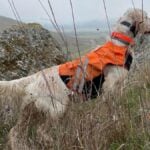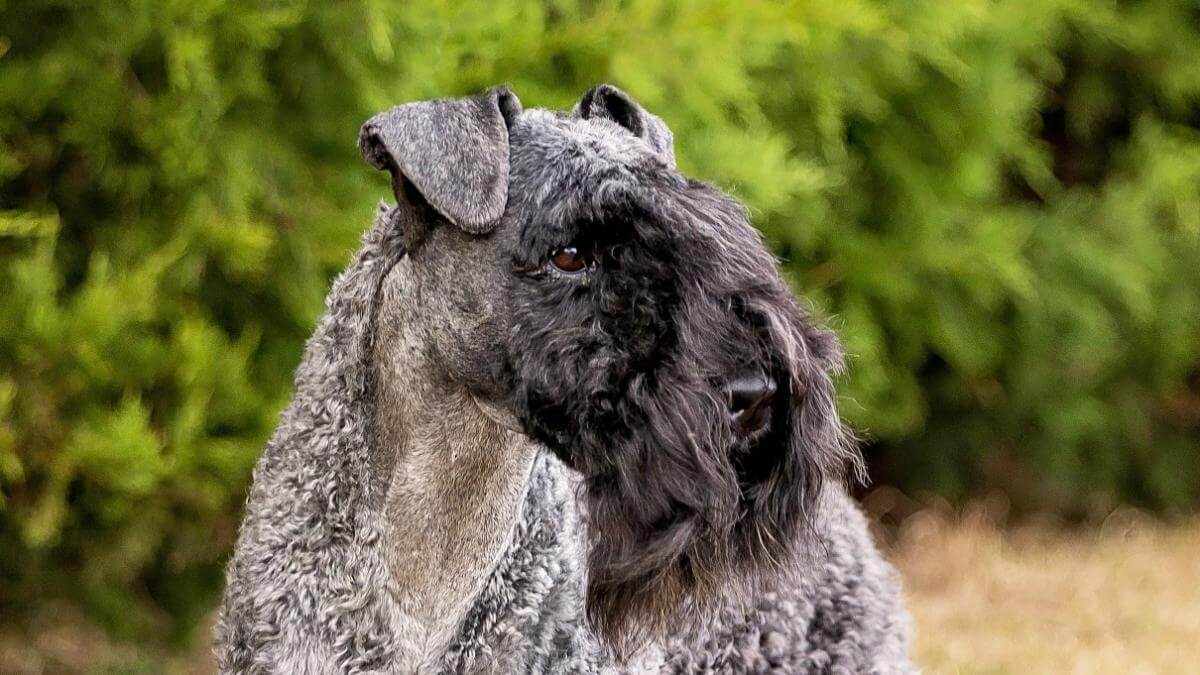
Home » The Kerry Blue Terrier

This article was originally published in Showsight Magazine, June 2014 issue.
When I was a young teenager in the late 1970s, my cousin and her husband had an Old English Sheepdog which they trained and showed to an AKC Companion Dog (CD) title, earning many awards at matches and trials along the way. I decided that one day I too would have a dog that I could successfully compete in obedience with, and the search for a suitable breed was on. In my junior high school library, I found a book on dog breeds that included a picture of an athletically built but very beautiful and unique-looking large terrier breed: the Kerry Blue Terrier. It was the accompanying text that clinched it for me, though; the author described the breed as a “canine Jack of all trades and a master at most.” In 1990, I finally got my first Kerry, thus beginning my 20+ year love affair with the breed, and my successful involvement in AKC obedience and many other dog sports.
Especially when I was competing in obedience with my first Kerry back in the 90s, judges and fellow competitors frequently commented on how surprised they were not only to see a Kerry Blue Terrier competing, but that he was actually good! I also encountered skepticism from breeders when I told them that I wanted a Kerry for obedience competition; the breeder I ended up getting my first two Kerries from even initially urged me to consider another breed. But, as I now advise people who are considering adding a Kerry or another breed to their family, the best indication of what to expect is to simply look at what the breed was historically used for. Kerry Blue Terriers were originally developed as all-purpose, working farm dogs: they were expected to guard, herd livestock, and even retrieve upland game in addition to the more traditional terrier jobs of vermin eradication, etc. In fact, the Kerry along with the closely related Soft Coated Wheaten Terriers are the only breeds in the Terrier Group that are allowed to compete in AKC herding tests and trials! So Kerries should be, and are, much like the herding and sporting breeds, very trainable and willing to please.
On the terrier side, there is a tendency for high prey drive, dominance challenges, some dog-on-dog aggression, and a bit of an independent streak! Forewarned is forearmed; early and ongoing training and socialization will produce both a family dog that is a joy to live with, and a performance dog that is willing and able to successfully compete in just about any activity you want to try with it. In 2004, the breed’s AKC parent club, United States Kerry Blue Terrier Club, created a Versatility Award in order to honor those Kerries that exemplify the breed’s original purpose by earning titles in multiple categories: conformation, obedience, rally, tracking, “earthdog” (actually either the AWTA’s Hunting Certificate or Barn Hunt, since Kerries are too large to compete in Earthdog trials), herding, and agility. A few years ago, an additional miscellaneous or “wild card” category was added to include activities that didn’t fit neatly into the other recognized categories such as AKC coursing ability and canine nosework. Although the Versatility Awards program does not normally recognize therapy or service dog certifications, the AKC’s Therapy Dog title (THD), which requires documentation of service hours logged in addition to certification, is accepted for this category.
The program currently recognizes a succession of seven different levels of achievement, from Bronze (for titles in two eligible categories) all the way up to Diamond (seven categories). To date, more than three dozen Kerries have been recognized for earning titles in two or more of these categories, with more Club members applying for their dogs’ Versatility Awards each year. Recipients so far include Champions and Grand Champions, obedience Utility Dog Excellent (UDX) and Rally Excellent Advanced (RAE) titlists, AKC Master Agility Champions, coursing ability titlists, a Tracking Dog (TD), and multiple herding titles. This year, several Kerries with the new Barn Hunt titles are expected to be added to the list. My current Kerry Blue Terrier, CH MACH2 Kerigolf’s Loaded For Bear UD RN MXC MJC MXF TQX CAA RATO HCT, is one of the Versatility Award program’s standouts. With eligible titles in conformation, agility, obedience, rally, coursing ability (wild card), Barn Hunt, and herding, 6-year-old “Remi” will become the breed’s first Diamond level Versatility Award recipient at the USKBTC’s annual membership meeting in October 2014. And like many of the Club’s other VA recipients, he did not simply earn the minimum title required for each category, but went well above and beyond in several! Remi finished his championship with back to back majors at a specialty weekend; ranked as the #5 or #6 agility Kerry for the last four years, has OTCH points and high in trial/high combined awards in obedience; and is one of the first Kerries to earn an open Barn Hunt title.
This past year, Remi made breed history by qualifying for all three AKC championship events being held in Harrisburg, PA the 2014 AKC National Agility Championships, National Obedience Invitational (along with two of his littermates), and Rally National Championships! I am still planning to start therapy dog work and earn an AKC Tracking Dog title (TD) with him. If we are successful at the latter, the USKBTC might need to add another recognition level to the Versatility Awards! But the titles and honors are secondary to the fact that Remi is a loving, well-trained and (usually) well-behaved family member that I love doing things with, and who is welcome almost anywhere I go. At a recent agility trial, a friend of mine overheard another exhibitor comment, “Now THAT’S exactly the kind of dog that should be bred!” Made my day! “Topper,” CH MACH4 Calix Cosmo V. Topper BN RA MXC MJC MXF TQX T2B2 RATN, owned by Patti Campbell of Virginia, is another Kerry that exemplifies the breed’s reputation for versatility. In addition to being one of the top-ranked agility Kerries for the past four years and earning the honor of top Kerry Blue Terrier at both the 2013 AKC Agility Invitational in Orlando and the 2013 Montgomery All Terrier Agility Cluster in Kimberton, PA last year, Topper finished his conformation championship, owner-handled, with specialty majors, and is a very popular reading dog at the local elementary schools.
Campbell has clicker-trained Topper to do a wide variety of fun “tricks,” which she uses not only to keep him focused and “up” while waiting to compete, but also puts them to good use in the many photographs and videos she posts on Facebook and elsewhere, making Topper one of the breed’s best-known ambassadors. With the addition of his recently earned novice Barn Hunt title, 7-year-old Topper, already a Silver-level Versatility Award recipient for previously earning titles in three categories (conformation, agility, and rally), is now eligible to join just a small handful of Kerries so far that have earned the Gold-level VA (titles in four categories) from the USKBTC. There are a few things I have learned from training Kerries over the years. First, Kerry Blue Terriers do much better when their minds and bodies are engaged, and they are included as part of the family. Like any relationship, you will only get out owning a Kerry what you put into it. Second, they do not respond well to “drilling” (repeating the same exercise over and over again). Short, fun, and frequent training sessions, with no more than two or three repetitions of any given exercise are best. Second, the trend towards using increasingly positive training methods (as opposed to the traditional military-style training, or “jerk and praise”) has really benefitted Kerry Blue Terriers along with many other breeds. In fact, I believe this is the main reason we are seeing an increasing variety of dog breeds successfully competing in obedience and other sports!
Please note, however, that by positive training, I do not mean pure positive or correction free. Corrections, though milder and less frequent, are still used when necessary, but the emphasis is on reinforcing desired behaviors with praise, food, and play rather than correcting or punishing undesirable behaviors. For example, a moment’s inattention may be corrected simply with a verbal reminder to “watch me,” and only followed with a mild collar pop (on a buckle collar) if the dog doesn’t respond to the verbal correction. Positive training does not mean wishy-washy; you still need to have clear expectations, and be fair, firm, and consistent in your training. How well you do this will determine whether you end up with one hellava dog, or the Dog From Hell.